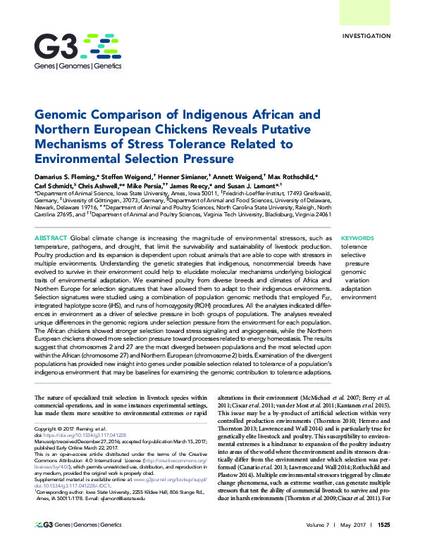
Global climate change is increasing the magnitude of environmental stressors, such as temperature, pathogens, and drought, that limit the survivability and sustainability of livestock production. Poultry production and its expansion is dependent upon robust animals that are able to cope with stressors in multiple environments. Understanding the genetic strategies that indigenous, noncommercial breeds have evolved to survive in their environment could help to elucidate molecular mechanisms underlying biological traits of environmental adaptation. We examined poultry from diverse breeds and climates of Africa and Northern Europe for selection signatures that have allowed them to adapt to their indigenous environments. Selection signatures were studied using a combination of population genomic methods that employed FST, integrated haplotype score (iHS), and runs of homozygosity (ROH) procedures. All the analyses indicated differences in environment as a driver of selective pressure in both groups of populations. The analyses revealed unique differences in the genomic regions under selection pressure from the environment for each population. The African chickens showed stronger selection toward stress signaling and angiogenesis, while the Northern European chickens showed more selection pressure toward processes related to energy homeostasis. The results suggest that chromosomes 2 and 27 are the most diverged between populations and the most selected upon within the African (chromosome 27) and Northern European (chromosome 2) birds. Examination of the divergent populations has provided new insight into genes under possible selection related to tolerance of a population’s indigenous environment that may be baselines for examining the genomic contribution to tolerance adaptions.
Available at: http://works.bepress.com/max-rothschild/176/

This article is published as Fleming, Damarius S., Steffen Weigend, Henner Simianer, Annett Weigend, Max Rothschild, Carl Schmidt, Chris Ashwell, Mike Persia, James Reecy, and Susan J. Lamont. "Genomic Comparison of Indigenous African and Northern European Chickens Reveals Putative Mechanisms of Stress Tolerance Related to Environmental Selection Pressure." G3: Genes, Genomes, Genetics 7, no. 5 (2017): 1525-1537. doi: 10.1534/g3.117.041228. Posted with permission.